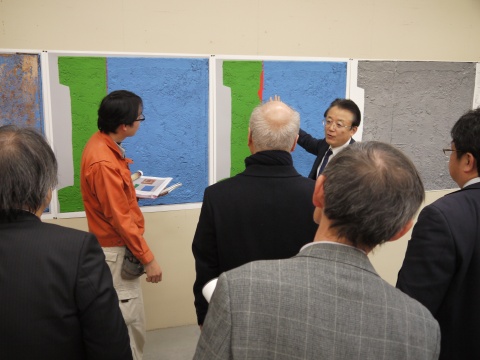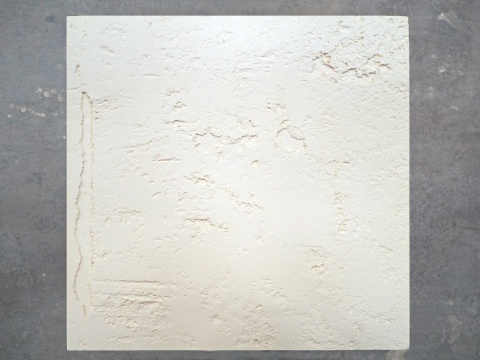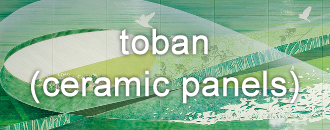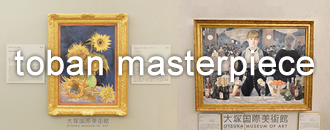Otsuka Ohmi Ceramics calls its reproductions of valuable cultural properties, such as paintings and other cultural properties, "Ceramic Archives" by replacing them with "Yakimono”.
The characteristics of ceramics make them less susceptible to the environment in which they are displayed, enabling visitors to feel closer to the paintings and cultural properties.
In this "Report on Reproduction of Cultural Properties," we will introduce the techniques for reproducing cultural properties and their applications related to the "Ceramic Archive”.
Takamatsuzuka Tumulus Mural x Latest 3D Technology
We have produced a variety of reproductions as part of the “Ceramic Archive” that combine the weather resistance and durability of pottery with the colors and textures expressed by Otsuka Ohmi Ceramic's proprietary technology.
Around 2014, Otsuka Ohmi Ceramics began producing reproductions by combining its proprietary technology with the latest 3D technology. The company has been working through a process of trial and error in order to achieve more realistic expressions.
Last year, we undertook a project to reproduce on ceramic boards, using 3D technology, the west wall mural of the Takamatsuzuka Tumulus Mural, which depicts the Asuka Beauties, a particularly famous group of women.
 ▲A reproduction of the west wall of the national treasure Takamatsuzuka Tumulus Mural. The "colors of the past" and "unevenness of the past" of the "Asuka Beauties" are reproduced.
▲A reproduction of the west wall of the national treasure Takamatsuzuka Tumulus Mural. The "colors of the past" and "unevenness of the past" of the "Asuka Beauties" are reproduced.
[About the National Treasure "Takamatsuzuka Tumulus Mural]
This is the first wall painting of a full-color tumulus discovered in Japan on March 21, 1972, and was built between the end of 7th century and the early 8th century. Inside the stone chamber, the star and the dragon, the sun and the moon, the four deities, and groups of figures (female and male) are depicted.
Together with the Kitora Tumulus Mural, this is one of only two precious, full-color "Tumulus Mural" wall paintings that have been discovered in Japan. Due to contamination by mold, the stone chamber was excavated in 2007, and the wall paintings inside were removed for conservation and restoration. In March 2020, the restoration work was completed after almost 12 years.
Challenge to reproduce with new ceramics that is different from the past
The major points of this production were to "reproduce the colors of the past (when the mural was discovered)" and "reproduce the unevenness of the past. Based on the current unevenness data and the past image data, we compared and verified them before proceeding with the work.
The reproductions we have worked on in the past have "replaced" the "current" state of the cultural properties with ceramics. This time, however, a new facsimile was required to be made, "as the original had deteriorated (due to mold contamination, etc.), we had to reproduce the condition of the original in three dimensions, taking into account its current condition" (according to Dr. Masanori Aoyagi, Director of the Archaeological Institute of Kashihara).
Such an unprecedented and new approach to reproduction. However, no one has seen it before and cannot imagine how it will turn out.
That is why, in order to organize the elements and deepen our understanding of how to reproduce the mural paintings in ceramics, we conducted research in the stone chamber of the tumulus where the murals were first discovered and received advice from experts who had seen the murals firsthand, technicians who were involved in the restoration work, the Agency for Cultural Affairs and people in various fields of expertise, and repeatedly made prototypes, which were reflected in this production.
Aiming for more realistic unevenness representation, the company took on the challenge of editing 3D data in-house.
In the production of the ceramic replica of the Takamatsuzuka Tumulus mural, the method of cutting the ceramic directly by molding fill for 3D processing on top of the base material of the original ceramic board was adopted. The 3D data for the cutting process was edited in-house.
▲In this case, the editing of the 3D data's unevenness expression was also done in-house.
The 3D data provided for the production were the latest and past data measured by the Archaeological Institute of Kashihara and the Nara National Research Institute for Cultural Properties, respectively. After discussions with the experts, it was decided that the latest 3D data would be used as the basis for production, but it was found that the 3D data had some shortcomings (areas that had not been fully measured).
We then proceeded with the 3D editing process, carefully confirming the rationale for each step, including how to fill in the missing parts and how to edit the data, after discussing internally with experts how to fill in the missing parts from the previously measured 3D data. [Photo 1]
 ▲Photo 1: A printout of the 3D editing process was pasted on the wall, which was then shown to the specialists for explanation. The editing process is carried out while confirming each process in detail.
▲Photo 1: A printout of the 3D editing process was pasted on the wall, which was then shown to the specialists for explanation. The editing process is carried out while confirming each process in detail.
Fusion of ceramics technology and 3D technology cultivated in the company's history / Sincere response to diverse requests
Based on the resulting 3D data, the ceramic board is directly machined. [Photo 2]
We aimed for an error of 1 mm or less with the measurement data. However, in areas where the blade of the cutting machine does not fit or where it is necessary to remove soil from an angle, skilled technicians perform the final finishing of the unevenness by hand. [Photo 3]
“We were also shown the actual mural during the restoration process, and our goal was to reproduce more 'realistic' unevenness. Even so, it is difficult to express the soft look of plaster on a ceramic board." (Employee)
The ceramic boards that underwent this process were successfully fired to within 1 mm of the initial target error.
Reproduction of Takamatsuzuka Tumulus Mural - The "Asuka Beauties" come vividly to life (Part 2)▶
 ▲Photo 2: Ceramic board with cutting process
▲Photo 2: Ceramic board with cutting process ▲Photo 3: Hand processing. Parts that cannot be removed by machine are cut by hand while checking against data.
Reproduction of Takamatsuzuka Tumulus Mural - The Asuka Beauties come vividly to life (Part 1)(PDF)



